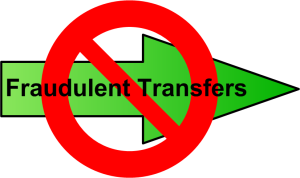
Asset Protection Lawyer Liability
Asset Protection Lawyer Liability
“Asset Protection” is often an inherent part, or natural result, of effective Estate Planning. Just what “asset protection” means varies widely from lawyer to lawyer, and client to client. The off-the-shelf definition of asset protection seldom fits the client’s exact needs without alteration. Likewise, the risks associated with asset protection as part of estate planning can vary significantly.
The lawyer’s goal on the one hand is to appropriately manage risk to protect the client’s interests. The pitfall all lawyers hope to avoid is throwing themselves under the bus to save a client by incurring personal liability in connection with the planning. Most difficulties in this regard arise in connection with fraudulent conveyances. In general, a conveyance can be constructively fraudulent or actually fraudulent.
While state statutes may vary somewhat, under Section 5(a) of the Uniform Fraudulent Transfer Act (the “UFTA”) a transfer is constructively fraudulent if:
- the transfer was made without the transferor receiving reasonably equivalent value in exchange for the transfer; and
- the transferor was insolvent at the time of the transfer or is rendered insolvent as a result of the transfer.
Under Section 4(b) of the UFTA, a transfer is actually fraudulent if it was made with “actual intent to hinder, delay or defraud any creditor of the debtor.” To aid in determining “actual intent,” the UFTA lists eleven non-exclusive factors to be considered:
- the transfer was to an insider (including certain relatives);
- the debtor retained possession or control of the property transferred after the transfer;
- the transfer or obligation was disclosed or concealed;
- the debtor had been sued or threatened with suit before the transfer was made or obligation was incurred;
- the transfer was of substantially all the debtor’s assets;
- the debtor absconded;
- the debtor removed or concealed assets;
- the value of the consideration received by the debtor was reasonably equivalent to the value of the asset transferred or the amount of the obligation incurred;
- the debtor was insolvent or became insolvent shortly after the transfer was made or the obligation was incurred;
- the transfer occurred shortly before or shortly after a substantial debt was incurred; and
- the debtor transferred the essential assets of the business to a lienor who transferred the assets to an insider of the debtor.
The goal is, of course, to make sure that all transfers (other than “gifts”) in an estate plan are made WITH adequate consideration and DO NOT render the client insolvent. This avoids constructive fraudulent conveyance. With gifts, the goal is to make sure that the planning is implemented for actual estate planning purposes, not for defrauding creditors, and that the other badges of fraudulent intent are not present. There are well documented tests for whether or not a transfer is appropriate.
Asset Protection is best served cold, and improves with time.
It is important to be aware that clients who have either a general or specific concern about exposure to liability, will often also have legitimate tax and family concerns that merit estate planning solutions. The potential for attorney liability arises not just from what is done, but why it is done, and when.
History of Attorney Liability
An attorney’s exposure to personal liability for asset protection planning has long been a murky issue. The exposure varies state to state. Some states, such as Delaware (6 Del. Code Ann. § 1307(c)), provide express immunity for attorneys from third party claims in aiding their clients. In my experience, the ethics section of continuing legal education courses focus on what not to do, and often scare more than guide in preventing asset protection lawyer liability. Then, in the practical real world applications, lawyers are left to sort out what they should and should not do legally and ethically to aid a client in protecting assets. The law is no more clear or certain today than it has ever been.
Just before I started my law practice, in 1985 an Arizona Appellate decision held that there is a cause of action for conspiracy to commit a fraudulent conveyance independent of the fraudulent conveyance statute then in force in Arizona. McElhanon v. Hing, 728 P.2d256 (Ariz. App. 1985).
In 1990, when Arizona adopted the Uniform Fraudulent Transfer Act (“UFTA”) (A.R.S. §44-1001, et. seq.), the issue of an attorney’s personal liability for a client’s fraudulent conveyance became less obvious. The ruling of two courts indicated that there was no longer a common law cause of action for aiding and abetting or conspiring to commit a fraudulent transfer. (In Moore v. Browning, 50 P. 3d 852 (Ariz. App. 2002); In Mann v. GTCR Golder Rauner, L.L.C., 483 F. Supp. 2d 864 (D. Ariz. 2007).)
A recent unpublished decision of the Bankruptcy Court for the District of Arizona may put the issue of personal liability for attorneys involved in fraudulent conveyances in a different light. (In re Kohner, 2014 WL 4639920, Bk.D.Ariz. Sept. 11, 2014). The applicability of this case is a bit circuitous since it is actually a dismissal of a Complaint for failing to properly plead a cause of action. However, the bankruptcy Trustee in In re Kohner claimed, in line with the 1985 McElhanon case, that there is a common law cause of action for conspiracy to commit fraudulent transfers in spite of Arizona’s adoption of the UFTA.
Although the Court noted that it was not deciding this issue, it also made is clear that the Court agreed with this position. The court relied in part on another Arizona case, In re Hashim, 356 B.R. 728 (Bank.D. Ariz. 2007) to declare that at least in Arizona there is a common law cause of action for conspiring to commit a fraudulent transfer independent from the UFTA.
If there is such a common law cause of action against the lawyer who aided the client in the planning, it will have far reaching consequences. This unpublished decision spooked the Arizona bar enough that they have raised the alarm with an email blast to practitioners. Asset protection lawyer liability is a live issue. At the moment at least, it is yet to be litigated at the Superior Court level. Then there will be appeals. Then we will have to see how far the Arizona decisions reach into other jurisdictions.
Moral of the Story
When doing asset protection, don’t make fraudulent conveyances. That is the best way to avoid lawyer liability for asset protection.
Ideally, all transfers will be made far in advance of any claims, for adequate consideration, without rendering the client insolvent, with other assets (including insurance coverage) available to satisfy known and anticipated claims, with the client able to retain control, with the client able to turn all the cards face up and hide nothing, and at the same time, make certain assets unavailable to creditor claims.
It also helps when the purpose and motive for establishing business entities is to generate more business revenue, which of course means there will be more, not less, available to satisfy any creditor claims that may arise. One of the ironies of asset protection is that when done right, legitimate creditors are often better provided for, and it is only the opportunistic predators and nuisance abusers of the legal system that are unable to reach the assets.
For Those Who Need Asset Protection
Don’t wait. Act early. Last minute asset protection is less effective, costs more, and renders some strategies simply unavailable. When the house is on fire, it’s too late to install smoke alarms or run to the store to buy fire extinguishers. Fraudulent conveyances and the resulting trouble for both the client and the client’s attorney happen most often when the planning is a last minute event. Procrastination is the enemy of asset protection and the friend of your creditors.
